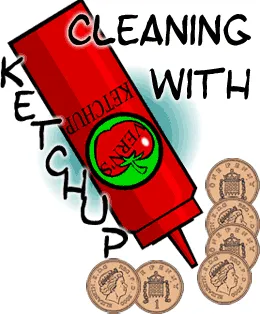 The Teacher's Corner
The Teacher's Corner
Ketchup on Your Cleaning
This week's experiment is another of those classics that have been around for ages. Even though it is fairly well know, most people do not know why it works.
You will need:
- several pennies
- ketchup (also known as catsup or tomato sauce) or vinegar
You want to use pennies that are brown, instead of bright and shiny. Don't use pennies from your coin collection, as this could cause them to lose some of their value.
 We are going to clean the pennies with the ketchup. Put a little ketchup onto a plate. You want enough to cover an area about the size of 3-4 pennies. Place some pennies into the ketchup. You may need to add more ketchup to cover them. Let them sit for a minute and then (this is the messy part) rub them with your fingers. Rinse them off in the sink and you will find that you have some bright, shiny pennies.
We are going to clean the pennies with the ketchup. Put a little ketchup onto a plate. You want enough to cover an area about the size of 3-4 pennies. Place some pennies into the ketchup. You may need to add more ketchup to cover them. Let them sit for a minute and then (this is the messy part) rub them with your fingers. Rinse them off in the sink and you will find that you have some bright, shiny pennies.
What happened? Why were they brown in the first place? A new penny is very shiny. The brown color on an old penny is copper oxide. Just as iron combines with oxygen to form rust, copper combines with oxygen to form copper oxide, which is brown.
This copper oxide forms a coating on the penny. When you put the penny into the ketchup, the vinegar in the ketchup combines with the copper oxide to form a chemical called copper acetate. Copper acetate dissolves in water, so you wind up with a nice, bright penny.
The reason that you don't want to do this with your coin collection is that you are removing some of the copper from the penny. This could remove some of the fine details and lessen the value of the coin for a collector.
 Check out more Experiments for kids
Check out more Experiments for kids
All lessons are brought to you by The Teacher's Corner and Robert Krampf's Science Education Company.
Robert Krampf's Science Shows thehappyscientist.com
